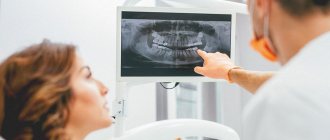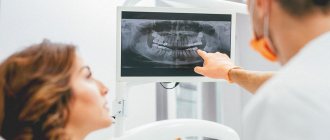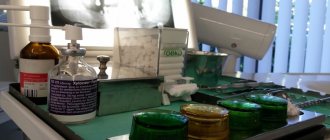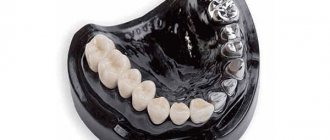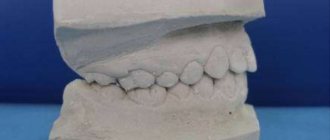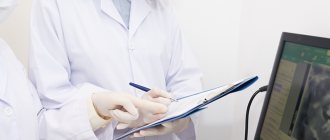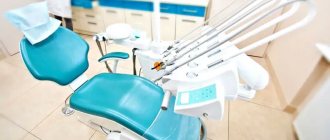Juristic documents
It is better to start preparing for opening a dentistry by choosing a premises. When examining the options, pay attention to the compliance of the apartment, extension or detached building with the requirements of the SES and firefighters. Or at least make sure that it is possible to bring the premises into compliance with these requirements.
Once you decide on the premises, the first document you put in the folder will be the lease agreement. It describes your relationship with the owner, the terms and amounts of rent, the rules for paying it, the obligations of the parties and their rights, as well as methods for resolving disputes and terminating the contract. If the agreement provides for a long-term lease (11 months or more), it must be registered with Rosreestr or the MFC.
Then you need to register a dental practice by choosing one of the forms of ownership: IP (Individual Entrepreneur) or Limited Liability Company (LLC). Each of them has its own advantages. The main advantage of an individual entrepreneur is the ease of registration. However, if your practice will not be limited to you and a nurse, or if you have a partner, it may be worth choosing an LLC. We will tell you what documents are needed to register a business in the section “Accounting documents”.
Next, you will need:
- permitting documentation from SES (Rospotrebnadzor) and Fire Inspectorate;
- license (or several licenses if a pediatric and surgical department is opened);
- copies of documents of employees and the head of the enterprise or individual entrepreneur confirming his professional level;
- tax number confirming registration.
If you are remodeling the premises, you need approval from the BTI. And if you build or add rooms for your clinic, you will have to obtain approval from the city architecture department and the local administration.
If your clinic plans to install x-ray equipment, you will need to obtain permission to use such equipment.
In addition, you are required to enter into agreements for:
- Disinfection, deratization, disinsection.
- Washing or dry cleaning of staff uniforms and woven household items.
- Removal and disposal of solid waste.
- Removal and disposal of mercury lamps.
- Removal and disposal of biological material.
- Maintenance of medical equipment.
- Study of the working environment and checking the sterility of instruments from the laboratories of the sanitation station.
- Monitoring the operation of autoclaves and other sterilization devices.
- Installation and periodic maintenance of fire alarm systems.
- To conduct routine medical examinations of employees with a medical institution.
You can specify the set of required documentation and collect it yourself, or you can hire an intermediary.
Standard equipment for an orthopedic dentistry office
Appendix No. 3 to the Procedure for providing medical care to the adult population for dental diseases, approved by order of the Ministry of Health and Social Development of the Russian Federation dated July 31, 2022 N 786n
STANDARD OF EQUIPMENT FOR A DENTAL CLINIC
Standard equipment for an orthopedic dentistry office
| N p/p | Code of type of nomenclature classification of medical devices <1> | Name of the type of medical device in accordance with the nomenclature classification of medical devices | Name of equipment (equipment) | Required quantity, pcs. |
| 1. | 119630 | Dental unit | Work place (set of equipment) for a dentist: Dental unit (US), including a dentist's unit (drill), a dental chair, a dental hydraulic unit, a dental operating lamp (these parts can be attached to a single supporting frame or attached mutually or separately to load-bearing structures (wall, furniture)) or Place working universal dentist (MRU), including a US equipped with a turbine, micromotor, diathermocoagulator, ultrasonic scaler, vacuum cleaner, X-ray viewer | at least 1 |
| 2.<2> | 122760 | Gas formaldehyde sterilizer | Sterilizer for instruments, in the absence of a centralized sterilization department | 1 |
| 125800 | Microwave sterilizer for unpackaged products | |||
| 330780 | Steam sterilizer | |||
| 125810 | Steam sterilizer for unpackaged products | |||
| 150480 | Ozone/hydrogen peroxide sterilizer | |||
| 173090 | Dry heat sterilizer | |||
| 183670 | Chemical liquid sterilizer | |||
| 188040 | Sterilizer-boiler | |||
| 211070 | Ethylene oxide sterilizer | |||
| 211110 | Ethylene oxide/steam sterilizer | |||
| 215790 | Plasma sterilizer | |||
| 237470 | Gas sterilizer based on hydrogen peroxide | |||
| 253700 | Steam sterilizer | |||
| 291960 | Electrolytic sterilizer | |||
| 330770 | Bactericidal sterilization chamber | |||
| 3.<4> | 119850 | External defibrillator with manual control | Automatic external defibrillator | 1 per department |
| 126500 | External automatic defibrillator for professional use, powered by rechargeable battery | |||
| 262440 | External semi-automatic defibrillator for professional use, powered by a non-rechargeable battery | |||
| 4. | 185950 | Distillation water purification system | Water distiller (medical) in the absence of a central sterilization unit | 1 |
| 5.<2><5> | 209330 | Dental X-ray intraoral system, mobile, digital | Dental X-ray machine with a digital image receiver (radiovisiograph) (in the absence of an X-ray room or an agreement with a medical organization that has a license for radiology work (services)) | at least 1 set (per department/office) |
| 191300 | Dental x-ray intraoral stationary system, digital | |||
| 191230 | Dental x-ray extraoral stationary system, digital | |||
| 173230 | Dental X-ray portable intraoral system, digital | |||
| 6.<2> | 269850 | Container for chemical disinfection system for medical instruments | Containers for disinfecting instruments | at least 1 |
| 185890 | Container for sterilization | |||
| 127550 | Ultrasonic bath for cleaning and disinfecting instruments | |||
| 7.<2> | 257280 | Container for collecting sharps and cutting medical waste | Container for collecting household and medical waste | at least 2 |
| 336200 | Package for collection, storage and transportation of medical waste | |||
| 123680 | Container for biological waste | |||
| 8. | 257280 | Container for collecting sharps and cutting medical waste | Container for disposal of syringes, needles and other disposable instruments | at least 1 |
| 9. | 113870 | Air compressor for medical products | Dental compressor (oil-free), in the absence of MRU and US or a centralized compressed air supply system | by design power |
| 10.<2> | 131980 | Ultraviolet bactericidal lamp | Germicidal irradiator/air purifier/device for disinfection and (or) air filtration and (or) disinfection of surfaces | 1 |
| 209360 | Mobile laminar flow installation | |||
| 152690 | High-efficiency filtering air purifier, mobile | |||
| 152700 | High-efficiency filtering air purifier, stationary | |||
| 292620 | Electrostatic deposition air purifier, mobile | |||
| 11. | 121250 | Dental/surgical polymerization lamp | Dental lamp for photopolymerization (light curing) in the absence of MRU and US | 1 |
| 12. | 282070 | Dental drill motor with remote control | Dental micromotor with or without optics if MRU and US are not included in the kit | at least 2 |
| 13.<2> | 119690 | Dental drill handpiece | Straight dental mechanical handpiece for micromotor if MRU and US are not included in the kit | at least 2 per workplace |
| 256310 | Handpiece of a combined dental drill with mains power | |||
| 282060 | Dental drill handpiece, with remote control | |||
| 14.<2> | 119690 | Dental drill handpiece | Dental mechanical angular handpiece for micromotor if MRU and US are not included in the kit | at least 2 per workplace |
| 256310 | Handpiece of a combined dental drill with mains power | |||
| 282060 | Dental drill handpiece, with remote control | |||
| 15. | 216740 | Dental drill handpiece, pneumatic | Dental turbine handpiece without fiber optics if MRU and US are not included in the kit and installed without fiber optics | at least 2 per workplace |
| 16.<2> | 238570 | Medical X-ray viewer, with power supply | X-ray viewer if MRU and US are not included in the kit | 1 per department |
| 238840 | Medical X-ray viewer, without electrical control | |||
| 17.<2> | 146180 | LED dental lamp, mains powered | Dental lamp without MRU and US included in the kit | 1 per doctor’s workplace |
| 151730 | Dental reflected light lamp | |||
| 18. | 270010 | Surgical instrument table | Dental table | 1 |
| 19. | 121630 | Dentist stool | Chair for a dentist if MRU and US are not included in the kit | 1 |
| 20.<2> | 119180 | Cabinet for dental instruments | Medical cabinet for storing consumables | 1 |
| 260470 | General purpose rack | |||
| 139690 | Medicine storage cabinet | |||
| 270000 | Medical cabinet for instruments | |||
| 21. | 215850 | Pharmaceutical refrigerator | Refrigerator for storing medicines | 1 per medical organization |
| 22.<4> | 279970 | First aid kit containing medicines | Layout of emergency prevention of parenteral infections for primary health care, emergency medical care, specialized medical care and palliative care <3> | 1 per office |
<1> Part 2 of Article 38 of the Federal Law of November 21, 2011 N 323-FZ “On the fundamentals of protecting the health of citizens in the Russian Federation” (Collected Legislation of the Russian Federation, 2011, N 48, Art. 6724).
<2> One of the following items must be present.
<3> Clause 5.2.12 of the Regulations on the Ministry of Health of the Russian Federation, approved by Decree of the Government of the Russian Federation of June 19, 2012 N 608 (Collected Legislation of the Russian Federation, 2012, N 26, Art. 3526; 2016, N 9, Art. 1268 ).
<4> Recognized as invalid according to the order of the Ministry of Health of the Russian Federation dated February 18, 2021 No. 109n “On introducing changes to the Procedure for providing medical care to the adult population for dental diseases, approved by order of the Ministry of Health of the Russian Federation dated July 31, 2020 No. 786n.”
<5> Updated in accordance with the order of the Ministry of Health of the Russian Federation dated February 18, 2021 No. 109n “On amendments to the Procedure for providing medical care to the adult population for dental diseases, approved by order of the Ministry of Health of the Russian Federation dated July 31, 2022 No. 786n.”
Accounting documents
In order to legally accept payments from customers, even in cash, you need to install an online cash register. You can avoid this if you are an individual entrepreneur and pay taxes under the patent system. You can also postpone the purchase of a cash register for a grace period and issue checks to customers that are subject to strict accounting.
The online cash register is registered with the Federal Tax Service. This is also done in at least 3 steps:
- We issue a cash register management system (account card for a cash register).
- We conclude an agreement for the purchase of media that stores and transmits fiscal data.
- Connecting to the Internet
If you open a clinic as an LLC, you will have to limit the amount of cash allowed to be kept in the cash register. The rest of the cash should be delivered to the Central Bank. To do this, you will need to enter into an agreement for the collection of funds.
Basic accounting documentation will appear after the opening of dentistry. These are documents confirming the provision of services to clients and receipt of payment from them. This group also includes orders for consumables and equipment, certificates for them, acts of acceptance and transfer of purchased equipment, registration cards confirming the placement of equipment on the balance sheet (if you have opened an LLC), reports to the tax office
These documents, with the exception of certificates for equipment, are not needed to open a business, so we include in the “accounting” group the package of papers required for registering a business.
When registering as an individual entrepreneur, you need to provide only four documents:
- Application with a request to register you as an individual entrepreneur (filled out in the prescribed form).
- A copy of a document confirming the identity of the future entrepreneur (usually a passport, the original is presented, a copy is submitted);
- A receipt confirming payment of the established state contribution;
- individual tax number (TIN).
To register the Society, you will also need a receipt for payment of the contribution to the state, an application for business registration and passports of all members of the society.
In addition, you should prepare:
- a document confirming the voluntary creation of a company - the decision of the founders and the Voting Protocol (if there is more than one founder);
- Statutory documents;
- an order appointing the first person of the clinic (this can be either an employee or the owner of a private practice);
- a document confirming that the clinic has a legal address (letter of guarantee from the landlord, card for the delivery of the premises to the balance sheet).
A certificate of authorized capital or other documents may be required at the discretion of the tax authorities.
What documents does a dental clinic need to successfully provide paid medical services?
Doctors ask me these questions at seminars year after year:
— What happens if you don’t conclude an agreement with the patient? — We conclude an Agreement and sign an Informed Consent, isn’t that enough? — How to properly maintain medical documentation when providing paid medical services? — Which documentation needs to be signed at each appointment, and which is enough to sign once? — Do I need to conclude a contract for each service separately? — What needs to be changed in the Agreement for the provision of paid dental services so that it protects the clinic from claims? — What documentation protects against patient claims? — What is the minimum list of documentation required for a clinic to successfully pass an inspection by Rospotrebnadzor? — We keep documentation electronically, do we need a paper copy? — Who are “consumer extremists” in dentistry and how to protect yourself from them?
14 years of experience working with dental clinics (complaints, courts, inspections) allow me to formulate the main points so that you understand why certain actions are needed and when they need to be carried out, and can consciously choose the minimum amount of “paperwork” that must be completed with a specific patient .
For those who want to fully understand the issue, I suggest you conduct a master class right now (in front of the monitor): COLLECT all DOCUMENTS (agreement, consent, deed, memo, etc.) that are maintained for patients in your clinic and, as you read , IMMEDIATELY NOTE which important points are reflected in it (= not in vain, we continue ), and which are worth adding , and which are unnecessary (you don’t have to burden doctors and administrators).
If you don't compare your documentation with what is written in the article, you will not be able to find out exactly how things are REALLY going at YOUR CLINIC?
— Is your clinic READY for the Rospotrebnadzor INSPECTION?
— Will your Clinic be able to DEFEND its INTERESTS against an unscrupulous patient?
Right now I am representing the interests of one clinic in a lawsuit filed by a patient who is dissatisfied with the result of yoke prosthetics, which she herself agreed to (the doctor strongly suggested a different design) and even wrote a receipt dictated by the doctor in the card (picture for this article).
At the same time, the doctor and the director are naturally very surprised that in court she demands the return of 75 rubles for prosthetics and 35 moral damages. I will say in advance - in the best case scenario , we will be able to agree on a partial refund (only for the arcs) in the amount of 36 rubles and sign a settlement agreement at the court hearing.
That is why I call such receipts, coupled with the lack of other necessary documents, THE MOST IMPORTANT MISCONCEPTION among doctors. This misconception is based on sincere trust in the oral agreement that the doctor had with the patient (receipts mean NOTHING!!!). Doctors measure by themselves, by their personal beliefs about the need to keep their word. Judicial practice shows, trust, but sign the documentation with the patient!
The requirements that we are now considering would save this clinic at least 46 thousand rubles . =36 + 10 (legal costs)! Therefore, it makes pragmatic sense to keep CORRECT documentation!
Below will be a list of necessary documents for an inspection by Rospotrebnadzor, so you will already know what documents need to be PREPARED for a scheduled inspection, as well as whether the CONTENT of the documents corresponds to judicial PRACTICE in dentistry.
Documentation in the clinic serves TWO purposes: to ensure that no violations are detected during inspections (Rospotrebnadzor, Roszdravnadzor and the Ministry of Health) and to protect against claims, complaints and lawsuits (as they taught at the institute “we write a medical record for the prosecutor,” remember?)
We've collected the documents - let's get started!
Two main concepts:
1. Who pays the money to the patient or at whose expense is the work remade?
A simple scheme of legal liability:
Treatment – Claim – Lawsuit – Clinic – Payment
Those. The Clinic always pays for the doctor , except for shadow medical services, when the doctor takes payment “over the counter.” Therefore, protecting the clinic from financial claims and lawsuits is the task of the clinic’s management. You can only demand from the doctor strict adherence to the rules, which we will discuss below.
2. Who is a “ consumer extremist ”?
This is a patient for whom, from a medical point of view, everything was done correctly, but he either violated the rules of use (broke the prosthesis) or was dissatisfied with the aesthetics (wrong color filling (therapy), teeth of the wrong shape (prosthetics), wrong smile (orthodontics), etc. .p.) and demands either to redo it for free, or to return the money (at the same time, he naturally wants to stay with his teeth).
The higher the skills in identifying such patients during consultation (after which they need to be refused), the fewer complaints there are. Therefore, management should pay maximum attention to new doctors (with an unclear history - whether they had any complaints) and young specialists (who have not gained independent experience or have not been trained at SEMINARS).
Conclusion No. 1 : the patient will always recover from the clinic and the owner’s task is to insure against payments for complaints to doctors. There is no other way, because... The human factor is at work here (the doctor did not recognize the “extremist”), he received a conflict and took (or missed) personal experience from this case.
Conclusion No. 2 . Documentation can be minimal (for inspections only) or optimal (for inspections and defense against claims).
WHAT IS NEEDED FOR CHECKS ? During inspections, Rospotrebnadzor (sometimes Roszdranadzor and the Ministry of Health) checks compliance with the requirements of the legislation on the provision of paid medical services, specific requirements stem from: 1. The Law “On the Protection of Consumer Rights”, which prescribes additional rights for the patient-consumer, 2. Resolution of the Government of the Russian Federation No. 1006 “Rules for the provision of paid medical services” (effective from January 1, 2013). These standards establish a MANDATORY List of documentation for the provision of paid medical services:
Check whether the clinic maintains the following documents: 1. Medical record, 2. Agreement for the provision of paid medical services, 3. Informed voluntary consent for the provision of paid medical services, 4. Consent to the processing of personal data, 5. Cash receipt (receipt), 6 Certificate of services performed, 7. Rules for the provision of paid medical services in the clinic, 8. List of paid medical services indicating prices in rubles, 9. Information about medical workers, the level of their professional education and qualifications, Working hours of the medical organization and the work schedule of medical employees (information stand and website); 10. Warranty provisions
Attention : If we do not have a contract, or the contract is old (developed before January 1, 2013 - PPRF 1006 requires many new competitive clauses in the contract), then during a scheduled inspection or inspection based on a patient complaint, violations will be identified.
Conclusion No. 3 . When is full documentation not needed? If you work in an office alone, or are 100% confident in the quality of your doctors’ work and that your doctors in 100% of cases will suspect those problematic patients who need to be refused and will do so, then you need a minimum list of documents ( for inspectors) - according to this list, samples can be found on the Internet or taken from colleagues, but with changes after January 1, 2013. - be careful, you can often download or borrow outdated samples.
Attention! How to check the quality and completeness of documentation in your clinic for free - details here (opens in a new window).
Now let's return to the patient - the consumer. The Law “On the Protection of Consumer Rights” prescribes additional rights for the patient-consumer: 1. the right to information about the service, 2. the right to the quality of the service (the expected result).
Everyone seems to know that the patient needs to be told everything and choose the appropriate treatment option together with him, but practically NO ONE KNOWS that judicial practice requires that (clinic) must prove the information
Conclusion No. 4 . If you cannot PROVE IN WRITTEN WHAT you told the patient at the appointment, WHAT treatment was agreed upon, WHAT the result will be, WHAT restrictions on use (teeth, dentures, braces, etc.), then, according to the law, it will be considered that YOU VIOLATED THE RIGHTS CONSUMER!!!
Please note that the court does not take into account the idea that your oral testimony “I told this to the patient” is not taken into account, because the patient will give contrary indications .
Therefore, the strategy of the “consumer extremist” is to “FORGET” what the doctor told at the appointment.
Similarly, with the result expected by the patient, or we prove WHAT recommendations were given, warned about the duration, the inability to achieve a certain shade, etc. or VIOLATE consumer rights (to quality).
Conclusion No. 5 . In case of violation of consumer rights, according to the law, the Clinic must (without guilt) at the patient’s choice: 1. Redo it free of charge, 2. Reduce the cost, 3. Return the money, 4. Pay the cost of the rework in another clinic.
Without going into the needs, in court you can lose up to 500% of the cost of services (which is what “consumer extremism” is actually based on: work + penalty (up to 100% of the price) + fine in favor of the patient (100% of the price) + fine in favor of the state ( 100% of the price) + legal costs.
Simple statistics show that sooner or later, ALL clinics are faced with claims (if they are not resolved, by the courts).
Conclusion No. 6 . Complete documentation ( anti-claim ) is needed to protect against claims (no need to pay for claims from unscrupulous patients).
What is the clinic's annual SAVINGS?
Explicit savings = the amount of free alterations and returns (with CORRECT documentation, up to 90% of alterations and returns can be avoided and there WILL BE NO CONFLICTS, since everything is written down in the documentation). I will not give numbers, they are VERY large if each rework (return) is considered through the prism of its real validity.
For the mentioned clinic, the savings would be 46 - 150 thousand rubles.
Hidden savings - a system for maintaining complete documentation DISCIPLINES the doctor and improves his communication with the patient (not “at random”, but to fill out documentation with a clear PURPOSE and in the right order: Plan, Consent, Memo, Act with filling out special sections with the INDIVIDUAL characteristics of the patient) .
Savings arise from preventing leakage from the flow of converting primary into repeat customers. These numbers are calculated in the clinic only with VERY GOOD marketing. It’s easier to offer the director of the clinic a banner, text advertisement, promotion, right? (now, due to the ban on advertising specific medical services (types of activity = dentistry - you can advertise), it’s time to find out how effective your advertising expenses were and create a portrait of your client).
What documentation do you have? Let's check : A documentation system that protects against complaints, claims and claims (anti-claim) must contain ALL of the following: 1. Agreement - look at the “Responsibility of the Parties” section of your agreement - Is there a condition there that if something that is written occurs? in the Informed Consent, then the clinic does not return the money? 2. Informed Voluntary Consent - look at whether all risky and expensive types of dental services have consents, are consents PART of the contract? 3. Does the clinic maintain a Certificate of Services Performed? How do you prove that the patient was satisfied with the result when submitting the work? 4. To what documents is the guarantee LIMITED in the clinic? (Patient's Guarantee Passport, Consent, Regulations?) – if you do not limit the warranty, then for ALL services it is automatically set to TWO YEARS! 5. What services are there a Patient Reminder for? How do you prove that patients are not following care instructions? How is the memo related to the Agreement, Consent, Medical Card? 6. How is Refusal of Alternative Treatment recorded in the clinic? How do you prove that the patient was informed about a cheaper alternative? 7. Regulations on the Medical Commission - a mandatory document that can be turned into an effective tool to prove that the patient received the aesthetic result that he agreed to before the start of services? 8. Some important documents that we create already in the process of a dispute with a patient: Refusal of the patient’s claim, Settlement agreement, Certificate of assessment of the quality of medical services provided, Conclusion of the Council.
If all of your first 7 points are NOT a single SYSTEM (one BIG contract prescribing = proving the CONDITIONS to which the patient agreed before the provision of services), then you are NOT PROTECTED from the arbitrariness of patients and any competent medical lawyer can recover from the clinic up to 500% of the cost services paid for by the patient.
Therefore, all sorts of consents, receipts, etc. that exist separately from the contract, mislead doctors, because they think THAT these documents protect them.
Learn more about how you can check the quality and completeness of your clinic’s documentation for free using the link.
Conclusion No. 7 . anti-claim documentation system protects the clinic from possible claims of unscrupulous patients and insures against “psychological” mistakes - when the patient was “underinformed” (did not bring the patient’s expectations to the real possibilities of your treatment) or did not identify a “consumer extremist” and did not refuse him reception and got a problem.
For your convenience, I have prepared completely ready-made documents that were mentioned in the article, a ready-made system that protects both from claims and from inspections .
You only need to insert the details of your clinic into the header of each document.
You can request a complete list of documents by sending me an email or ordering documentation using the link.
If you go to the website, at the bottom of the page you will find a table with the cost of documentation.
Please note that all documents: - Complies with the requirements of modern legislation - Have been tested by judicial practice. — When legislation changes, you receive a free update.
There is a unique offer only for small offices (up to two chairs) - if you are interested, please ask.
Please note that I have been continuously working with documentation for 12 years (I am making amendments, covering up the next loopholes of patients identified after the next court cases), so you receive the result of a large, highly specialized work based on PRACTICE (not theoretical calculations of lawyers after a review of legislation) for a cost significantly less than the loss of even one claim .
How long will it take to implement this system in my clinic?
You just need to enter the details of your clinic, which will take the administrator no more than 2 hours and the documentation is ready to go!
What if we work with an electronic medical record?
You must clearly understand that an electronic card does not relieve you of the obligation to have a paper copy with the patient’s SIGNATURES in key places (Agreement, Plan, Consents, Act, Memo, Guarantee Passport)!!! That is, all pages with signatures must be printed and signed, and the card itself can remain on the computer (printed on demand).
To what extent will the system complicate the work of doctors and administrators?
In fact, there is only a simplification of the work: You once carry out the necessary Regulations, Rules, etc. in the clinic with orders, and in the current work the staff uses a minimum set of documentation: 1. A contract - for large work there is a separate one, for ordinary therapy services - it is enough to have an agreement signed once and store it with the card = no need to sign a new agreement every time!!! 2. Plan (for complex multi-stage services) 3. Informed consents (for expensive and potentially problematic services) 4. Certificate of completed services (for expensive and potentially problematic services) 5. Guarantee passport (for expensive and potentially problematic services) This is the list that must be maintained on the basis of the requirements of the law, and now these documents also PROTECT you from claims!
We have it all! Why should we change?
The purpose of the review is for you to check how ALL of it corresponds to what you want. If you are NOT interested in protection from problem patients, then you only need a minimum list of documents for checks.
We obtained consent from one large clinic, they have a whole staff of lawyers there, don’t they really work?
First of all, it is not the consents themselves that are important, but a unified system that will only completely protect your clinic. Anti-claim consents are : 1. an element of this system, 2. developed on the basis of many years of experience working with dental clinics (documentation audit) and conducting seminars for dentists, where doctors learn to see the client’s expectations and effectively advise him. It is these basic information and problematic points in specific phrases that are reflected in the standard agreements. 3. The main thing is that each consent contains specific phrases on the most frequently arising claims and special legal wording that protects the doctor and the clinic (based on our own experience in litigation between patients and clinics).
Now is a favorable time to restore order; prepare in advance for the escalation of “consumer extremism”!
Order
With wishes from grateful patients, Artem Voropaev, medical lawyer.
Workplace equipment
Equipment, furniture, consumables
The list of equipment will depend on what you plan to do. For example, if you are opening a fertility clinic, you are unlikely to need an MRI, X-ray, or dental unit. But an ultrasound machine and cryo-devices will be needed.
In addition to equipment, you will need auxiliary items to carry out the procedures. Their number depends on the size of the clinic, the list of services, the number of rooms and the flow of patients:
- stands for droppers;
- medical instruments and consumables (tweezers, syringes, bandages, etc.);
- medicines;
- bactericidal air recirculator, etc.
Don't forget about furniture for offices and for medical purposes. If you are drawing up a plan for how to open a dental clinic, then provide special chairs for patients, and if you want to open a children's clinic, then purchase furniture for a play waiting area, etc. Here is a minimum list of furniture that may be useful to you:
- couches;
- gurneys;
- chairs;
- cabinets for medicines and consumables;
- operating tables/dental/gynecological chairs;
- furniture and office equipment for doctors' offices and administrative personnel.
Software
If previously all records at the registry were kept in handwritten journals, today special programs are used to work with patients - CRM systems. You can use them to make appointments for clients, maintain cards, record treatment history, and manage all transactions and payments. Let's look at the main capabilities of these programs using the S2 CRM system as an example:
1. You can maintain an electronic patient record.
All the information necessary for the doctor is stored in separate tabs in the system:
- general data: full name, age, diagnosis and any other information;
- logbook: information about all patient visits to the clinic;
- examinations: protocols of each visit with details of prescriptions and treatment;
- invoices: information about all client payments;
- history of work with the client: on the right, the card contains all the doctor’s and administrator’s notes, letters from the client, call recordings.
Electronic patient card in S2 CRM.
2. Course of treatment
(list of medications and dosage)
can be printed in one click
and given to the client: you enter into the client’s card what medications you need to take, and the CRM will automatically format the data into a beautiful recipe. You can create a branded recipe template and it will populate itself.
3. Conveniently register clients with specialists
in the interactive calendar, both for an individual appointment and for a group appointment (for example, for exercise therapy).
In it, you can set the work schedule of all doctors, and the CRM will show free windows for appointments. This eliminates the risk of mistakenly scheduling several patients at the same time: the system simply will not allow you to do this. In addition, you can add an unlimited number of specialists to one calendar. You can also create several calendars to manage different branches of the clinic.
So in S2 CRM you can make an appointment for a patient in 2 clicks.
4. CRM can be
integrated with the website
and set up an appointment widget on it, so that patients can, by visiting your website, make an appointment with a doctor online, choosing a specialist and a convenient time. And you will see this entry in CRM as a new request.
5. If
you integrate the system with an SMS mailing service
, you can send reminders to clients about an upcoming appointment: this way they will not forget to come and will become more loyal.
Organization and conduct of briefings
All dental, clinic or medical center personnel must undergo occupational safety training. The following types of instruction are distinguished:
- Induction training is conducted for all employees without exception upon employment. During this briefing, the employee is told the general safety requirements that must be observed on the territory of the medical facility.
- Initial briefing at the workplace - is carried out to the employee upon employment immediately after completing the introductory briefing. During this training, the employee is informed about the safety requirements that must be observed in a particular workplace.
- Repeated instruction – carried out at least once every six months. This briefing is intended to remind and reinforce the requirements of initial training in the workplace.
- Unscheduled briefing – carried out in special cases specified in clause 2.1.6. Resolutions of the Ministry of Labor of the Russian Federation and the Ministry of Education of the Russian Federation of January 13, 2003 N 1/29 “On approval of the Procedure for training in labor protection and testing knowledge of labor protection requirements for employees of organizations”
- Targeted briefing – carried out before performing one-time work; emergency response; holding mass events.
The fact of conducting labor safety briefings must be reflected in the relevant journals, indicating the date and signatures of the person being instructed and the person instructing.

